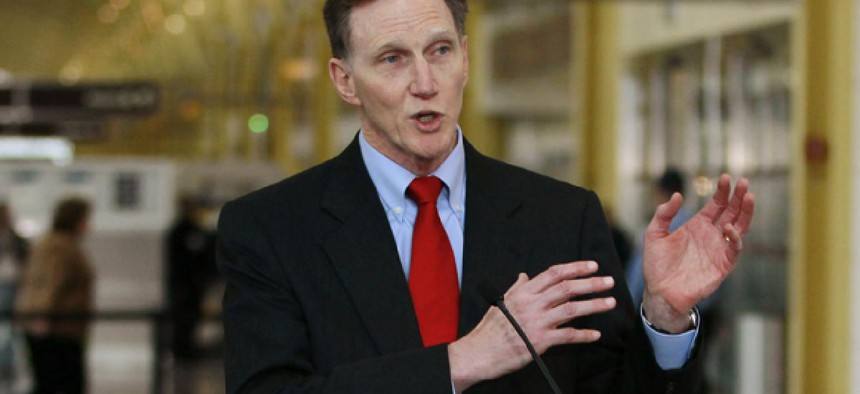
TSA Administrator John Pistole Charles Dharapak/AP
TSA chief says 30 percent or 40 percent staff cut wouldn’t fly
Downsizing would hamper security efforts and lengthen wait times, Pistole tells GOP lawmaker.
Citing the Transportation Security Administration’s “bloated workforce,” a House subcommittee chairman on Thursday asked TSA Administrator John Pistole whether his agency’s 46,000-strong team of airport and surface transportation screeners could be reduced by 30 percent or 40 percent.
Pistole said no, declining to offer his own estimate for how deep a cut TSA could sustain at a time when the agency is facing budget decreases by House appropriators.
“Mr. Pistole, I believe you are too bogged down in managing an oversized workforce to mitigate the next potential threat,” said Rep. Mike Rogers, R-Ala., chairman of the House Homeland Security Subcommittee on Transportation Security, at a hearing titled, TSA’s Efforts to Fix Its Poor Customer Service Reputation and Become a Leaner, Smarter Agency.
Rogers also faulted TSA for not moving faster with its switch to more risk-based priorities in screening passengers. “You have a serious image problem,” he told Pistole. “The American people go to airports and see people standing around, doing nothing.” He protested the recent screening of VIPs such as former Secretary of State Henry Kissinger and the continuing confiscation of passenger water bottles and pocket knives.
“Half of Congress wants to get rid of TSA and until you get the confidence of the American people, you have a big problem,” Rogers said.
Pistole reminded the panel that TSA had recently eased pat-downs of children younger than 12 and the elderly older than 75, and that a one-day training program for supervisors and screeners has been delivered to 60 percent of staff, even though it lacks congressional funding. “In the past, TSA was criticized for going too fast, for rolling out technology before it was ready,” he added, noting that when TSA was first stood up after the Sept. 11, 2001, terrorist attacks, it had one year to staff up to nearly 50,000 employees.
As for public complaints, Pistole said of 525,000 calls to TSA’s call center in 2011, only 6 percent or 7 percent were complaints. “Most people who come to our town halls are there not to compliment us, but to deliver constructive criticisms,” he said. “Our work is sometimes confrontational; it’s not a popularity contest. You’ll never get 100 percent satisfaction.”
Pistole also argued “anecdotes drive” some of the negative impressions. “You don’t hear from the other 99 percent who travel,” he said, noting Kissinger himself had not protested an airport pat-down; the complaint came from an onlooker. “But it is clearly on us” to address the complaints, he added. Response to the training programs has been highly positive, he said, and “the sooner we move to the risk-based [approach, the better.]”
Rogers suggested that TSA hire an outside firm to perform a customer satisfaction survey. “No one believes you’ve got the right number of people,” he continued. "What is the right percentage to cut? Twenty-five percent? 20 percent?”
Pistole said providing such a percentage is a “challenging proposal from a number of standpoints, and would require a significant assessment” that factors in efficiency and staff modeling from 450 airports. Currently, 14,000 TSA employees work part time during peak travel times, he added, noting Congress hasn’t funded them for full-time work. “Those we have now are necessary,” Pistole said, “and if we reduce the staff by X percent, it would have impact on wait times."
Rogers replied, “You know it’s not going to get bigger.”







